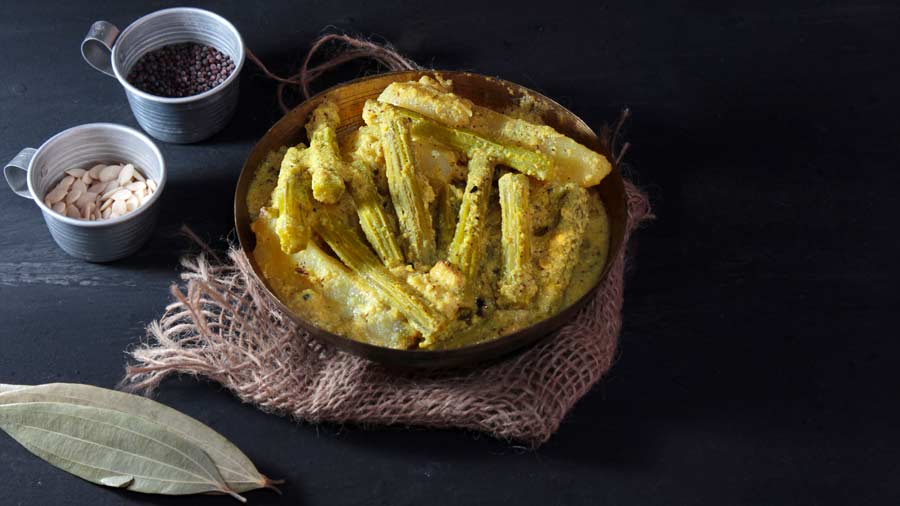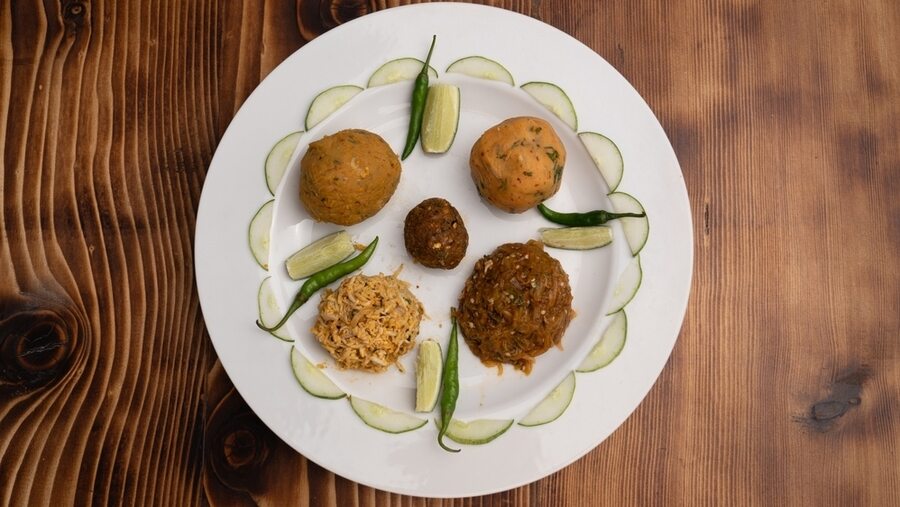The word teto doesn’t engage your senses instantly. It quite literally means bitter, and may seem like an odd choice for a palate pleaser in a course-based meal. However, it takes the bracing and pungent bitterness of shukto to complete a quintessential Bengali spread.
A Bengali cookbook could be a good place to start if you’re looking to explore the merits of a bitter course. In her book, A Taste of Time: A Food History of Calcutta, Mohona Kanjilal has dedicated an entire chapter on the significance of teto in Bengali cuisine. “Bitter preparations are classified as teto. The stress it lays on the importance of the consumption of bitter ingredients makes Bengali cuisine quite scientific in nature. It not only recognises the value of bitterness as a palate cleanser, but following ayurvedic traditions, also has high regard for its medicinal properties,” she writes.
There’s no one way to cook Shukto — mainly because Bengal grows a variety of naturally bitter greens to choose from — be it korola (bitter gourd), neem, shojne (drumsticks) or varieties of shak such as helencha (watercress), thankuni pata (Indian pennywort), bitter cumin and shojne phul (moringa), most of which also boast some medicinal virtues. In fact, some culinary experts believe that shukto is not a single dish, but a category of bitter, stewed curries, meant to be served as the first course in a Bengali meal. It’s usually a fibre-rich powerhouse of nutrients and also prepares the taste buds for the heavily-seasoned courses that follow.
The bite of the bitter
Consuming bitters to start a meal isn’t exclusive to Bengali culinary traditions. There’s the Maharashtrian Kaarlyachi Bhaaji (a bitter gourd curry), Kerala’s Pavakka curry and the Parsi bhaji dana, which is a versatile and elegant fenugreek number that can also be served as a side.

Neem Shukto Rinku Mitra
Bengali kitchens, however, have a slew of deft bitter recipes besides the shukto. There’s the neem begun (neem leaves and fried diced eggplant), tetor dal (featuring bitter gourd), and the popular ucche bhaja (crispy fried bitter gourd).
But the shukto remains the most alluring salve to Bengali meals. The classic shukto is a milky, green stew (the milk alleviates the potent bitterness to some degree), which can accommodate a varied number of seasonal veggies and even some piscine accents. Some East Bengali recipes use lean fish varieties (like magur and rohu to make maachher shukto).
Wildly popular on both sides of the Padma
In fact, there is an ongoing Ghoti-Bangal debate over the origins of shukto, considering the bitter stew is wildly popular in almost every household, on both sides of the Padma. Since bitter gourds were commonly grown in Bangladesh, and neem trees are also common there, some experts argue that the prevalence of consuming teto was first started by the Bangals. However, some theories believe that the process of stir-frying locally available produce and then turning them into a stew was influenced by Portuguese cuisine since Portuguese cookery has had a big impact on Bengali food.
Shukto’s Ayurvedic roots however have been noted throughout history. The act of consuming bitter foods has been an Ayurvedic dietary practice. Sages and physicians like Susruta, Charaka and Dhanwantari have mentioned the medicinal properties of bitters.
In Mangal Kavya too, mentions of shukto can be spotted. Some historians have connected shukto with Sri Chaitanya and the Bhakti movement, which was an important milestone dating back to the middle ages. So, it’s entirely possible that the Portuguese borrowed the recipe from Bengal and took it back with them. Meanwhile, Bengali kitchens started adding commonly found condiments like mustard oil, bori, radhuni and even pithalu (a mixture of maida milk or water to make the gravy thick) to make the shukto more palatable.
Whatever be its origin tale, the hearty and bitter shukto reigns supreme in Bengali households. So, if you’re looking for a beginner-friendly teto recipe for this weekend, explore Pragyasundari Debi’s bitter moringa curry recipe, from the Shuktoni section of her book Aamish O Niramish Aahar.
Sojne Phuler Rai
Ingredients:
- Sojne phul ( moringa flowers) – 125gms
- Mustard paste – 1 and a half teaspoon
- Nalte pata (edible leaves of the jute plant. They are bitter in taste) – 5 or 6
For the phoron
- Whole mustard – 1 ½ teaspoon
- Mustard oil – Two tablespoons
- Black pepper paste – Half a teaspoon
- Salt to taste
Method
- Clean the moringa flowers.
- In a kadhai, pour mustard oil. After it is heated whole mustard needs to be added.
- Add the moringa flowers along with the mustard paste.
- After stirring a bit, add salt and the jute leaves.
- Add the black pepper paste. Let it simmer for a minute. It’s ready!


